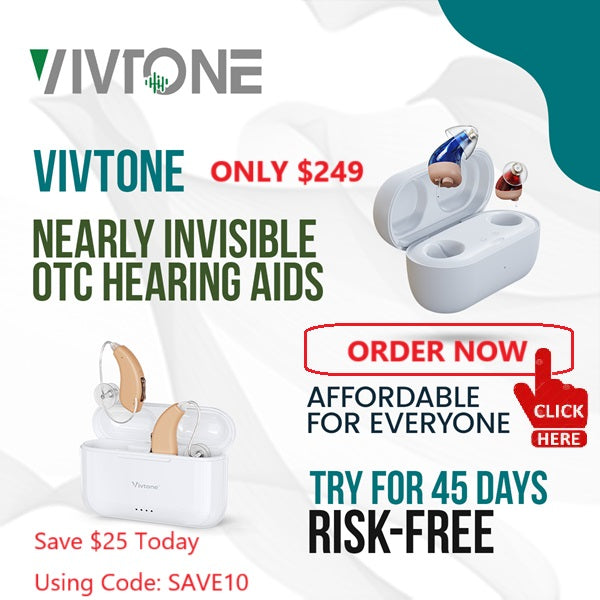Complete Guide to ITE Hearing Aids: A Discreet Solution for Clearer Hearing

Hearing loss affects millions. Custom-made In-the-Ear (ITE) hearing aids offer a discreet, comfortable solution, fitting snugly in the ear canal or outer ear to amplify sound and improve hearing.
Demand for inconspicuous ITEs is rising over traditional BTEs due to their custom fit and comfort. ITEs feature advanced technology like noise reduction and wireless connectivity for an enhanced experience. This guide covers their significance, features, benefits, ideal users, and limitations.
What are ITE Hearing Aids?
ITE hearing aids, also known as in the ear hearing aids, are like personal ear companions crafted exclusively for you. These custom-made wonders snugly fit either in your ear canal or the outer part of your ear. Created with utmost precision, they're tailored to your unique ear shape, size, and even color, ensuring a comfortable and inconspicuous experience.
Compared to other types of hearing aids, ITE hearing aid devices offer several distinctive features. Here are the primary differences:
1. Design and placement
ITE hearing aids are custom-made to fit the unique contours of an individual's ear. They are available in different sizes, from full-shell models that fill most of the outer ear to smaller models that fit partially inside the ear canal. This custom design allows for a snug and comfortable fit, ensuring that the device stays securely in place.
2. Visibility
One of the significant advantages of ITE hearing aids is their discreet appearance. Since they are custom-made, they blend in with the natural shape and color of the ear, making them less noticeable compared to other types of hearing aids. This discreet design is particularly appealing to individuals who prefer a more inconspicuous hearing solution.
3. User convenience
ITE hearing aids are generally easy to handle and adjust. Their larger size compared to other types of hearing aids makes them more user-friendly, as they offer larger controls and batteries that are easier to manage, particularly for individuals with dexterity issues.
4. Sound amplification
Due to their placement in or close to the ear canal, ITE hearing aids provide natural sound amplification. This proximity allows for improved sound localization, as the device is positioned closer to the sound source, capturing sound more accurately. The customization of the device also ensures a better fit, which helps reduce feedback or whistling sounds.
Advantages of ITE Hearing Aids
ITE hearing aids provide significant advantages. These cutting-edge devices offer numerous benefits compared to other hearing aid types, enhancing the user experience in multiple ways.
1. Discreet appearance
A key benefit is their discreet look. Custom-made to fit your ear's shape and color, they are less noticeable, boosting confidence in social and professional situations.
2. Custom fit
Personalized using an ear impression, they offer a snug, secure fit. This enhances comfort and prevents them from shifting or falling out during daily activities, ensuring reliability.
3. Comfort
Designed for optimal comfort, they fit ear contours perfectly. This ergonomic design eliminates irritation from glasses or hats, unlike some other styles, ensuring comfortable extended wear.
4. Ease of use
Their larger size can allow for easier handling with bigger controls, ideal for dexterity issues. Larger batteries also offer extended life, reducing the frequency of changes.
5. Sound quality
Placed near the ear canal, they offer natural sound amplification and clarity by reducing transmission distance. The custom fit minimizes feedback, allowing for better sound perception.
6. Additional features
ITE aids feature advanced tech like noise reduction and directional mics. Wireless connectivity allows seamless connection to devices like smartphones, improving adaptability in various listening environments.
Customization and Fitting Process
Acquiring ITE hearing aids involves a meticulous process ensuring a custom fit and optimal performance. Here are the typical steps towards achieving better hearing with these devices.
1. Consultation
Your journey starts with consulting an audiologist. They evaluate your hearing, discuss needs and lifestyle, and determine if ITE aids are suitable for you.
2. Ear impressions
If ITE aids are appropriate, painless ear impressions are taken using soft material. These are crucial for creating your custom-fit hearing aids in just a few minutes.
3. Customization
Impressions go to a lab where technicians create a precise mold of your ear. This mold forms the basis for crafting your comfortable and secure custom ITE hearing aids.
4. Fitting appointment
At your fitting appointment, the audiologist places the custom aids, adjusts settings for your hearing needs, verifies performance, and teaches you usage and maintenance basics.
5. Follow-Up and Adjustments
Follow-up visits allow the audiologist to fine-tune settings based on your experience, address concerns, and optimize performance, ensuring you get the most from your hearing aids.
Professional guidance is vital. Audiologists select suitable aids, take accurate impressions, ensure proper fit, and customize settings, maximizing comfort and performance for your specific needs and lifestyle.
Technology and Features
ITE hearing aids boast advanced technology, enhancing listening. Common features improve clarity, reduce noise, and offer connectivity, significantly improving the user experience in various environments.
Noise reduction
Advanced noise reduction minimizes background sounds, enhancing speech clarity. Aids analyze the environment and adjust settings automatically, prioritizing conversation in noisy places for better focus.
Directional microphones
These focus on sounds from the front, reducing noise from other directions. This improves speech understanding, especially in challenging situations with competing background sounds.
Feedback management
Modern ITE aids use systems to minimize or eliminate whistling (feedback). They quickly detect and suppress feedback for a comfortable, clear listening experience without annoying sounds.
Wireless connectivity
Many offer wireless options, like Bluetooth, connecting to smartphones and TVs. Users can stream calls or audio directly, enhancing convenience and engagement with media and communication.
Telecoil technology
Some include telecoils (T-coils) for connecting to hearing loop systems in public venues. This delivers clearer audio directly, reducing background noise effectively.
Environmental adaptation
Automatic adaptation identifies sound environments and adjusts settings accordingly. For example, switching programs for noise or optimizing for music enhances performance seamlessly across different situations.
Rechargeable batteries
Many modern ITE aids feature rechargeable batteries, eliminating frequent replacements. Simply dock overnight for a full day's use, adding convenience and reducing ongoing costs.
Note that features vary by model and manufacturer. Consulting an audiologist is crucial to understand options and select features that best match your specific hearing needs and preferences.
Suitable Candidates for ITE Hearing Aids
In the ear hearing aids are suitable for a wide range of individuals with hearing loss, but certain factors make them particularly well-suited for certain candidates based on their hearing loss and lifestyle. Here are some considerations for identifying ideal candidates for ITE hearing aids:
- Mild to Moderate Hearing Loss: ITE hearing aids are typically suitable for individuals with mild to moderate hearing loss. They offer sufficient amplification to address the needs of individuals with these degrees of hearing loss. However, for severe or profound hearing loss, other types of hearing aids, such as behind-the-ear (BTE) or receiver-in-canal (RIC) hearing aids, may be more appropriate.
- Ear Anatomy and Shape: ITE hearing aids require an ear canal or outer ear that can accommodate the device comfortably. Candidates with normal ear anatomy, suitable ear canal length, and absence of excessive earwax or other ear conditions are generally good candidates for ITE hearing aids. However, individuals with very small ear canals or specific ear irregularities may find other types of hearing aids more suitable.
- Discreet Appearance: Individuals who prioritize the discreetness of their hearing aids often opt for ITE hearing aid devices. People who feel self-conscious about wearing visible hearing aids or prefer a more inconspicuous solution may find hearing aids in the ear appealing. The custom fit and placement within the ear contribute to their discreet appearance.
- Lifestyle Considerations: ITE hearing aids offer compatibility with diverse lifestyles, particularly for individuals who lead dynamic lives involving physical activities or sports. These devices are aptly designed to provide a customized fit, ensuring a secure and stable placement that significantly reduces the likelihood of dislodgement or accidental removal during movement.
- Dexterity and Vision: ITE hearing aids may be preferable for individuals with dexterity or vision impairments. Their larger size compared to other types of hearing aids makes them easier to handle, manipulate, and adjust. The larger controls and buttons can be beneficial for individuals who have difficulty with small or intricate tasks.
- Sensitivity to Wind Noise: ITE hearing aids, being positioned within the ear, are generally less susceptible to wind noise compared to BTE or RIC devices. This can be advantageous for individuals who spend a significant amount of time outdoors or in windy environments.
Despite ITE hearing aid benefits, consulting an audiologist is crucial. They assess hearing loss, ear anatomy, lifestyle, and preferences to recommend the most suitable hearing aid solution tailored specifically for you, ensuring optimal results and satisfaction with your choice.
Care and Maintenance
Proper care ensures optimal ITE hearing aid performance and longevity. Follow tips to keep them in good condition.
Cleaning routine
Clean ITE aids regularly with a soft cloth/brush to remove wax/debris. Avoid water/solutions unless instructed by professionals.
Wax protection
Use manufacturer-provided wax guards/filters to minimize wax buildup. Replace these regularly as instructed by your provider.
Battery replacement
Follow instructions for replacing disposable batteries or charging rechargeables. Remove disposables when not in use for longer life.
Moisture protection
Protect ITE aids from moisture damage. Avoid wearing during swimming/showering. Store dry; consider using a dehumidifier/drying kit.
Avoid extreme temperatures
Avoid extreme temperatures (heat/cold/direct sun) which can damage ITE aids. Store cool and dry; never leave in vehicles.
Regular check-ups with audiologists
Schedule regular audiologist check-ups for cleaning, maintenance, adjustments, and expert guidance on care and usage.
Always follow manufacturer's care instructions. Contact your audiologist promptly for any issues or performance decline for assistance.
Potential Limitations
While beneficial, ITE hearing aids have potential limitations and drawbacks worth considering for a full understanding.
Visibility
Designed for discretion, visibility varies by ear shape/size. May be slightly visible from certain angles despite advancements.
Dexterity requirements
Smaller controls can be challenging for users with dexterity issues. Alternatives with larger controls or remotes exist.
Specific hearing loss types
Generally best for mild-moderate hearing loss. May not suit severe/profound loss, small canals, or certain ear conditions.
Feedback and occlusion
More prone to occlusion (blockage sensation) and feedback (whistling). Proper fitting and adjustments by an audiologist help.
Maintenance and repair
May require more maintenance/repair due to wax, moisture, debris exposure. Diligent cleaning and check-ups are necessary.
Conclusion
In-the-Ear (ITE) hearing aids are custom-fit, discreet options for mild-to-moderate loss, offering comfort and security. Advanced features enhance clarity but have limitations (dexterity, suitability). Key pros include custom fit and low visibility. Proper care is needed. Consult a professional for personalized assessment and the best choice.
FAQ
What is the typical battery life of ITE hearing aids?
Battery life varies (days to weeks) by model/usage. Requires regular replacement or recharging for continuous use.
What are the pros and cons of ITE hearing aids?
Pros: Custom fit, discreet, advanced features. Cons: Occlusion effect, damage risk, suitability limits for some losses/ears.
How much do in the ear hearing aids cost?
Costs vary widely ($100s-$1000s/ear) by brand/features. Consult a professional for personalized pricing and financial aid information.
Does insurance cover ITE hearing aids?
Coverage varies by provider/policy (none to full). Check your plan or contact insurer. Explore financial assistance programs too.
Can you pair ITE hearing aids with Bluetooth?
Yes, many models pair with Bluetooth for audio streaming. Compatibility varies by hearing aid model and manufacturer.
What is the best in the ear hearing aid on the market?
"Best" is subjective, depending on individual needs. Consult a hearing professional for personalized recommendations based on your requirements.





